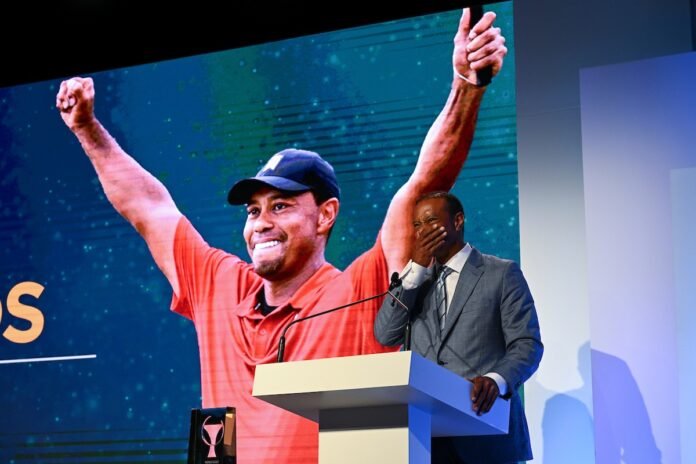
Memories came flashing back for Tiger Woods as he was inducted in to the World Golf Hall of Fame last night. Here is his acceptance speech.
Thank you. Crap, I just lost a bet that I wouldn’t cry (laughter). All the inductees, all the people who — all the past Hall of Famers who are here, players, the World Golf Hall of Fame committee, thank you for inducting me and passing me in here. Jay (Monahan), thank you for moving the age down from 50 to 45 (laughter).
I’m going to start kind of retro, so I’m going to go at 6- years-old, so 40 years ago. So at 6-years-old I was getting hooked to the game of golf. My dad was playing, and he was a member and was able to play at what was called the Navy Golf Course in Long Beach, California. In order to play as a dependent, you had to be 10-years-old or older. Obviously, I did not fit that criteria. So in order for me to kind of play in the game, we found a par-3 course at Heartwell Golf Park in Long Beach.
View this post on Instagram
So my mom took me there, and a pro, Rudy, at the time, my mom was like, hey, can my son play here and practice here a little bit? Okay, let me see him hit a few shots. Well, I hit a few shots, and he says, okay, he’s got unlimited balls. So that’s where I ended up starting playing.
Related: Tiger Woods, who kicked everyone’s butt, enters World Golf Hall of Fame
So fast forward a couple years, I’m now 8-years-old. I’d be dropped off — one of the great things about playing at Heartwell, they had a tournament every Saturday. So I spent the week practicing at the park right down the street. So my dog Boom-Boom and I, we’d go down to the park. I’d hit balls in the dark, in the grass, through trees, in the sand, through the hula hoops, everything. So my dog, I’d only hit two golf balls. He would go lay down next to each one of them. Well, that’s kind of how I learned to play the game of golf.
Well, at the age of 8, my mom during those tournament days was so supportive and so great, she would give me 75 cents. So 75 cents would allow me to buy a hot dog, and then 25 cents would be used to use the pay phone to call her to come pick me up. If the pay phone swallowed it, I had a backup.
View this post on Instagram
Well, that backup then turned into putting contests, which I ended up pocketing a few more quarters (laughter), which led into skins games, which led into dad’s finding out why — okay, how did you get more quarters? Then he’d say, okay, well, you can’t putt for quarters. Fine, done, I won’t putt for any more quarters. I come home a week later, I’ve got a pocket full of dollars (laughter).
I told you not to putt for quarters. I didn’t. Okay. No more putting for money. Done. Next week, come home with a pocket full of dollars. He said, I thought I told you never to putt for money again. I didn’t. I went out and played skins. (Laughter.)
So that was my introduction at about age 8 to about 10. So during that time my dad used to get off of work at 4:12 at McDonnell Douglas, and my mom would drop me off at the entryway to the golf course. Well, I would make my way to what they called the old back nine is The Ditch. My dad, as you have known, is a former special forces and a Green Beret.
So mom would drop me off. I would hop into the ditch. I would then walk on the south side of The Ditch because the clubhouse was perched up two stories. So they could only see on the Norse side of The Ditch. So I would sneak down the first hole to the second hole. But dad taught me how to always grab a piece of foliage, cover yourself up, listen for noise. If you hear anybody coming, lay still (laughter). Part sniper. So I would lay there, I would pick up golf balls. Obviously, military guys aren’t the straightest of players. So at the time I’d be in The Ditch finding golf balls, and as we all know back in those days, there was only Surlyn or balata.
View this post on Instagram
If I found a balata ball, are you kidding me? I’ve got a
brand new fresh balata, I can use this in a tournament.
Surlyn balls only used for practice. So I would walk in The Ditch, listen for noise, any cart traffic, any guys coming over from playing 18. If I hear them slice the ball in the trees, drop down, lay still, covered up. I would lay there under the bridge at the 3rd hole, and I’d sit there, and I’d just wait patiently, patiently. There would be a cart come up. You there? Yep, coming up. So my dad would be in the cart, and we’d go out there, and at the age of 8, I would play underage the golf course. And the great thing about Navy golf courses, the first nine holes played all the way out, kind of like a links course. So the further you went out, the further away you were from the clubhouse.
So when I got out there, it was by then, especially in the wintertime, it was already dark. So we had a rule, if you ever lost the golf ball, we’d be done, and we’d have to drive in. So part of understanding how to shape shots and knowing where I hit it on the face, where I would hit it all started then. So if I hit it, Dad, I pulled it left, it’s up the left side, it’s going to be here. We’d drive there, it’s there, we can continue playing. The furthest I ever made was 17 holes in the dark. Never quite got to 18.
But that — one of the things that drove me was his passion to play the game of golf. I was never going to be denied to play. I loved it. I had this burning desire to be able to express myself in this game of golf. One of the things that Dad had instilled in me is that he grew up in an era, same era as Charlie Sifford and why my son is named after Charlie, is that you had to be twice as good to be given half a chance. So that understanding and that drive, as Sam said, train hard, fight easy. I made practicing so difficult, hurt so much, because I wanted to make sure that I was ready come game time. I hit thousands of balls, hands bleeding, aching, just so that I could play in a tournament.
View this post on Instagram
Southern California Junior Golf Association had amazing tournaments throughout the summer. We’d play all these great golf courses. Now meanwhile, you have to understand, I only played Heartwell or snuck on the Navy golf course. So one of the neatest things in the world for me was to play on a golf course as I read the name of the golf course and it had the two letters afterward, CC. So I was going to go play a country club. We had these fresh greens, not these bouncy poa greens that’s all over the place where they’re cut probably twice a week. I’m going to get a chance to play fresh greens.
Well, playing at some of these golf courses, I was not allowed in the clubhouses where all the other juniors were. The color of my skin dictated that. As I got older, that drove me even more. So as I was denied access into the clubhouses, that’s fine.
Put my shoes on here in the parking lot. I asked two questions only that was it. Where was the 1st tee, and what was the course record. Not complicated. (Applause.) So throughout my junior golf days, we didn’t have the financial means to play some of the bigger events. As I progressed through the sport, our family made — or was forced to make a decision. As I became of age when I was about 14, 15, I was going to start playing what is called the AJGA, American Junior Golf Association. It was at that time in its infancy stages, but it was at that time where all the junior golf players were playing all around the country. I was there getting exposed to possible collegiate scholarships. College coaches were there to watch them play.
View this post on Instagram
Obviously, we didn’t know that we were going to have enough money for me to go to college or a top college or be recruited. So my family made a tough decision, and at the age of 14-1/2 we took out a second mortgage so I could go out and play the AJGA Tour. Mom stayed at home. Dad traveled. And I went out and played the AJGA Tour on our second mortgage. So without the sacrifices of Mom who took me to all those junior golf tournaments, and Dad, who’s not here, but who instilled in me this work ethic to fight for what I believe in, chase after my dreams, nigh If you don’t go out there and put in the work, you don’t go out and put in the effort, one, you’re not going to get the results, but two, and more importantly, you don’t deserve it. You need to earn it.
So that defined my upbringing. That defined my career, which allowed me to get into a great university like Stanford. From there, I turned pro. And Phil Knight is here, CEO of Nike, and at the time Wally Uihlein was the president and CEO of Titleist, very generous signing a little punk kid from Stanford at 20-years-old to these exorbitant contracts, first thing I was able to do is I was able to pay off that mortgage. (Applause.)
View this post on Instagram
I’ve gone to have a successful career. I’ve been able to play around the world, see cultures, playing different places. One of the goals I had early on in my career was to win on every single continent. I know that golf is an individual sport. We do things on our own a lot for hours on end, but in my case, I didn’t get here alone. I had unbelievable parents, mentors, friends, who allowed me and supported me in the toughest times, the darkest of times, and celebrated the highest of times.




